Examine the description of the CUSTOMERS table:
Which three statements will do an implicit conversion?
which three statements are true about indexes and their administration in an Oracle database?
Examine this list of requirements for a sequence:
1. Name:EMP_SEQ
2. First value returned:1
3. Duplicates are never permitted.
4. Provide values to be inserted into the EMPLOYEES.EMPLOYEE_ID COLUMN.
5. Reduce the chances of gaps in the values.
Which two statements will satisfy these requirements?
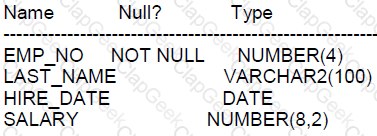
For each employee in department 90 you want to display:
1. their last name
2. the number of complete weeks they have been employed
The output must be sorted by the number of weeks, starting with the longest serving employee
first.Which statement will accomplish this?
Examine the description of the SALES1 table:
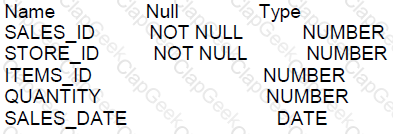
SALES2 is a table with the same description as SALES1,
Some sales data is duplicated In both tables.
You want to display the rows from the SALES1 table which are not present in the SALIES2 table.
Which set operator generates the required output?
Examine the description of the EMPLOYEES table:

Which statement will execute successfully, returning distinct employees with non-null first names?
Which two statements are true about the results of using the INTERSECT operator in compound queries?
Examine these statements which execute successfully:
ALTER SESSION SET NLS_DATE_FORMAT = ‘DD-MON-YYYY HH24 MI: SS’
ALTER SESSION SET TIME_ ZONE = ‘-5:00’;
SELECT DBTIMEZONE, SYSDATE FROM DUAL
Examine the result:

If LOCALTIMESTAMP was selected at the same time what would it return?
Examine the data in the EMPLOYEES table:

Which statement will compute the total annual compensation for each employee?
Examine this SQL statement
DELETE FROM employees e
WHERE EXISTS
(SELECT' dummy'
FROM emp history
WHERE employee_ id= e. employee id);
Which two are true?
You need to allow user ANDREW to:
1. Modify the TITLE and ADDRESS columns of your CUSTOMERS table.
2. GRANT tha permission to other users.
Which statement will do this?
Which two statements will return the names of the three employees with the lowest salaries?
Examine the description of the BRICKS table;

Examine the description of the BRICKS_STAGE table;

Which two queries execute successfully?
Examine the description of the EMPLOYEES table:

Which two queries return rows for employees whose manager works in a different department?
View the Exhibits and examine the structure of the COSTS and PROMOTIONS tables.
You want to display PROD IDS whose promotion cost is less than the highest cost PROD ID in a pro
motion time interval.
Examine this SQL statement:
SELECT prod id
FROM costs
WHERE promo id IN
(SELECT promo id
FROM promotions
WHERE promo_cost < ALL
(SELECT MAX (promo cost)
FROM promotions
GROUP BY (promo_end date-promo_begin_date)) );
What will be the result?
Examine the description of the EMPLOYEES table:

Which two statements will run successfully?
You execute these commands successfully:
CREATE GLOBAL TEMPORARY TABLE invoices _ gtt
( customer id INTEGER,
invoice_ total NUMBER (10, 2)
) ON COMMIT PRESERVE ROWS;
INSERT INTO invoices_ gtt VALUES (1, 100);
COMMIT;
Which two are true?
You execute this query:
SELECT TO CHAR (NEXT_DAY(LAST_DAY(SYSDATE),’MON’ ),’ dd“Monday for” fmMonth rrr’) FROM DUAL;
What is the result?
You and your colleague Andrew have these privileges on the EMPLOYEE_RECORDS table:
1. SELECT
2. INSERT
3. UPDATE
4. DELETE
You connect to the database instance an perform an update to some of the rows in
EMPLOYEE_RECORDS, but don’t commit yet.
Andrew connects to the database instance and queries the table
No othet user are accessing the table
Which two statements ate true at this point?
Examine the description of the PRODUCT_ STATUS table:

The STATUS column contains the values IN STOCK or OUT OF STocK for each row.
Which two queries will execute successfully?
The ORDERS table has a primary key constraint on the ORDER_ID column.
The ORDER_ITEMS table has a foreign key constraint on the ORDER_ID column, referencing the primary key of the ORDERS table.
The constraint is defined with on DELETE CASCADE.
There are rows in the ORDERS table with an ORDER_TOTAL less than 1000.
Which three DELETE statements execute successfully?
You execute these commands:
CREATE TABLE customers (customer id INTEGER, customer name VARCHAR2 (20));
INSERT INTO customers VALUES (1,‘Custmoer1 ‘);
SAVEPOINT post insert;
INSERT INTO customers VALUES (2, ’Customer2 ‘);
SELECTCOUNT (*) FROM customers;
Which two, used independently, can replace
Examine the description of the ORDER_ITEMS table:
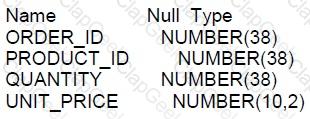
Examine this incomplete query:
SELECT DISTINCT quantity * unit_price total_paid FROM order_items ORDER BY
Which two can replace
View the Exhibit and examine the structure of the ORDERS table.
The columns ORDER_MODE and ORDER TOTAL have the default values'direct “and respectively.
Which two INSERT statements are valid? (Choose two.)
Examine the description of the PRODUCTS table:

Which two statements execute without errors?
A session's NLS_DATE_FORMAT is set to DD Mon YYYY .
Which two queries return the value 1 Jan 2019?
Examine the data in the INVOICES table:

Examine the data in the CURRENCIES table:
CURRENCY_CODE
-------------
JPY
GPB
CAD
EUR
USD
Which query returns the currencies in CURRENCIES that are not present in INVOICES?
Examine this statement:
CREATE TABTE orders
(sarial_no NUMBER UNIQUE,
order_id NUMBER PRIMARY KEY ,
order_date DATE NOT NULL,
status VARCHAR2 (10) CHECK (status IN ('CREDIT', 'CASH')),
product_id NUMBER REFERENCES products (product_id),
order_ total NUMBER);
On which two columns of the table will an index be created automatically?
Examine the description of the EMPLOYEES table:

Which two queries return the highest salary in the table?
Examine the description of the BOOKS table:

The table has 100 rows.
Examine this sequence of statements issued in a new session;
INSERT INTO BOOKS VALUES (‘ADV112’ , ‘Adventures of Tom Sawyer’, NULL, NULL);
SAVEPOINT a;
DELETE from books;
ROLLBACK TO SAVEPOINT a;
ROLLBACK;
Which two statements are true?
You issued this command: DROP TABLE hr. employees;
Which three statements are true?
Viev the Exhibit and examine the structure of the PRODUCT INFORMATION and INVENTORIEStables.
You have a requirement from the supplies department to give a list containing PRODUCT _ID,SUPPLIER ID, and QUANTITY_ON HAND for all the products where in QUANTITY ON HAND is lessthan five.
Which two SQL statements can accomplish the task? (Choose two)
Examine this business rule:
Each student can work on multiple projects and earth project can have multiple students.
You must decide an Entity Relationship (ER) model for optional data storage and allow generating reports in this format:
STUDENT_ID FIRST_NAME LAST_NAME PROJECT_ID PROJECT_NAME PROJECT_TASK Which two statements are true?
Examine the description of the EMPLOYEES table:
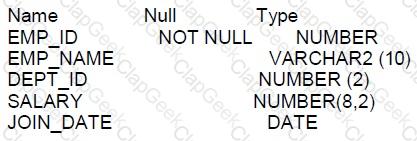
NLS_DATE_FORMAT is set to DD-MON-YY.
Which query requires explicit data type conversion?
Examine these statements:
CREATE TABLE alter_test (c1 VARCHAR2(10), c2 NUMBER(10));
INSERT INTO alter_test VALUES ('123', 123);
COMMIT;
Which is true ahout modifyIng the columns in AITER_TEST?
Examine the description of the employees table:

Examine these requirements:
1- Display the last name, date of hire and the number of years of service for each employee.
2. If the employee has been employed 5 or more years but less than 10, display -5+ years of service".
3. If the employee has been employed 10 or more years but less than 15, display "10+ years of
service".
4. If the employee has been employed 15 or more years, display "15-*- years of service".
5. If none of these conditions matches, display "<5 years of service".
6. Sort the results by the hire_date column.
Which statement satisfies all the requirements?
A)

B)

C)

D)

Examine the data in the COLORS table:

Examine the data in the BRICKS table:

Which two queries return all the rows from COLORS?
You need to calculate the number of days from 1st January 2019 until today.
Dates are stored in the default format of DD-MON-RR.
Which two queries give the required output?
Examine the description of EMPLOYEES table:
Which three queries return all rows for which SALARY+COMMISSION is greate than 20000?
Which four statements are true regarding primary and foreign key constraints and the effect they can have on table data?
Examine the description of the ENPLYEES table:

Which two queries return all rows for employees whose salary is greater than the average salary in their department?
Examine the description of the EMPLOYEES table:

The session time zone is the same as the database server
Which two statements will list only the employees who have been working with the company for more than five years?
Examine the data in the EMP table:

You execute this query:
SELECT deptno AS "Department", AVG(sal) AS AverageSalary, MAX(sal) AS "Max Salary"
FROM emp
WHERE sal >= 12000
GROUP BY "Department "
ORDER BY AverageSalary;
Why does an error occur?
Examine the BRICKS table:
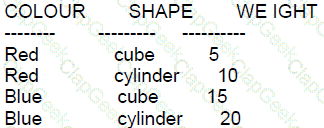
You write this query:
SELECT
FROM bricks b1 CROSS JOIN bricks b2
WHERE b1. Weight < b2. Weight:
How many rows will the query return?
Examine this business rule:
Each student can work on multiple projects and each project can have multiple students.
You must design an Entity Relationship(ER) model for optimal data storage and allow for generating reports in this format:

Which two statements are true?
The PROD_ID column is the foreign key in the SALES table.Which references the PRODUCTS table.
Similarly,the CUST_ID and TIME_ID columns are Also foreign keys in the SALES table referencing the CUSTOMERS and TIMES tables, respectively.
Evaluate the following CREATE TABLE command:
CREATE TABLE new_sales(prod_id, I cust_id, order_date DEFAULT SYSDATE)
AS SELECT I prod_id,cust_id,time_id FROM sales.
Which statement is true regarding the above command?
Examine the ORDER _ITEms table:

Which two queries return rows where QUANTITY is a multiple of ten?
The SALES table has columns PROD_ID and QUANTITY_SOLD of data type NUMBER. Which two queries execute successfully?
Examine this partial statement:
SELECT ename, sal,comm FROM emp
Now examine this output:
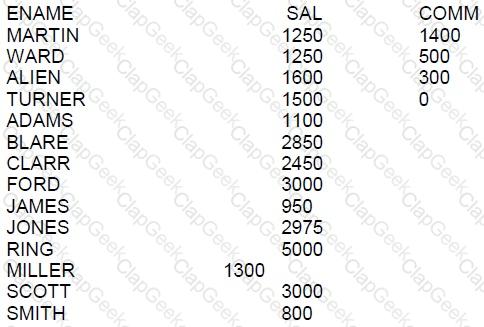
WHICH ORDER BY clause will generate the displayed output?